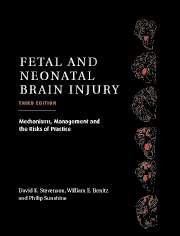Book contents
- Frontmatter
- Contents
- List of contributors
- Foreword
- Preface
- Part I Epidemiology, Pathophysiology, and Pathogenesis of Fetal and Neonatal Brain Injury
- Part II Pregnancy, Labor, and Delivery Complications Causing Brain Injury
- 9 Maternal diseases that affect fetal development
- 10 Antepartum evaluation of fetal well-being
- 11 Intrapartum evaluation of the fetus
- 12 Obstetrical conditions and practices that affect the fetus and newborn
- 13 Fetal and neonatal injury as a consequence of maternal substance abuse
- 14 Chorioamnionitis and its possible relation to subsequent cerebral palsy
- 15 Bacterial sepsis in the neonate
- 16 Neonatal bacterial meningitis
- 17 Neurological sequelae of congenital perinatal infection
- 18 Perinatal human immunodeficiency virus infection
- 19 Inborn errors of metabolism with features of hypoxic–ischemic encephalopathy
- Part III Diagnosis of the Infant with Asphyxia
- Part IV Specific Conditions Associated with Fetal and Neonatal Brain Injury
- Part V Management of the Depressed or Neurologically Dysfunctional Neonate
- Part VI Assessing the Outcome of the Asphyxiated Infant
- Index
- Plate section
17 - Neurological sequelae of congenital perinatal infection
from Part II - Pregnancy, Labor, and Delivery Complications Causing Brain Injury
Published online by Cambridge University Press: 10 November 2010
- Frontmatter
- Contents
- List of contributors
- Foreword
- Preface
- Part I Epidemiology, Pathophysiology, and Pathogenesis of Fetal and Neonatal Brain Injury
- Part II Pregnancy, Labor, and Delivery Complications Causing Brain Injury
- 9 Maternal diseases that affect fetal development
- 10 Antepartum evaluation of fetal well-being
- 11 Intrapartum evaluation of the fetus
- 12 Obstetrical conditions and practices that affect the fetus and newborn
- 13 Fetal and neonatal injury as a consequence of maternal substance abuse
- 14 Chorioamnionitis and its possible relation to subsequent cerebral palsy
- 15 Bacterial sepsis in the neonate
- 16 Neonatal bacterial meningitis
- 17 Neurological sequelae of congenital perinatal infection
- 18 Perinatal human immunodeficiency virus infection
- 19 Inborn errors of metabolism with features of hypoxic–ischemic encephalopathy
- Part III Diagnosis of the Infant with Asphyxia
- Part IV Specific Conditions Associated with Fetal and Neonatal Brain Injury
- Part V Management of the Depressed or Neurologically Dysfunctional Neonate
- Part VI Assessing the Outcome of the Asphyxiated Infant
- Index
- Plate section
Summary
Introduction
Maternal infections, contracted during pregnancy, may be without fetal consequence or they may have serious adverse effects on the fetus. These adverse effects may include fetal death, stillbirth, intrauterine growth retardation, or congenital infection. Congenitally infected neonates may be symptomatic or asymptomatic at birth. Those who are symptomatic at birth generally have significant long-term sequelae. Those who are asymptomatic at birth may never manifest evidence of damage or they may develop clinically evident sequelae later in life. The overwhelming morbidity attributable to congenital infections is borne by this latter group.
The following chapter will discuss the neurologic consequences of congenital infections. The specific infectious agents that will be discussed are often referred to as the TORCH agents; T represents the parasite Toxoplasma gondii; O represents other agents such as varicella-zoster virus (VZV), human immunodeficiency virus (HIV), and Treponema pallidum (syphilis); R represents rubella virus; C represents cytomegalovirus (CMV); and H represents herpes simplex virus (HSV). With the exception of HSV, the major clinical impact of these agents results from exposure in utero. Morbidity and mortality attributable to neonatal HSV infection usually result from infection contracted at delivery.
Toxoplasmosis
The etiologic agent of toxoplasmosis, Toxoplasma gondii, was first demonstrated in the brain of a newborn infant with encephalomyelitis in 1939. The incidence of congenital toxoplasmosis in the USA is estimated to range from 1:1000 to 1:10,000 live births. Among immunocompetent women, transmission to the fetus is limited almost solely to those who contract primary infection during gestation.
- Type
- Chapter
- Information
- Fetal and Neonatal Brain InjuryMechanisms, Management and the Risks of Practice, pp. 355 - 376Publisher: Cambridge University PressPrint publication year: 2003



